
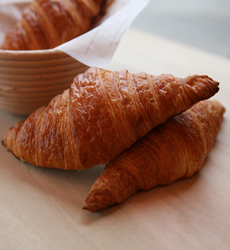
Croissants are made of puff pastry. When filled with chocolate, they are called pain au chocolate or chocolate croissants. Photo courtesy Exserting.
August 2008
Last Updated December 2025
|
 |
All Types Of Breads
Page 7: Pain Au Chocolat, Panettone, Panforte & Other Breads With P
This is page 7 of a 9-page glossary of all types of breads. Click on the links below to visit other pages. You can also return to the overview and the history of bread or look at our many other food glossaries.
Click on a letter to go to the appropriate glossary section:
a b c d e f g h i j k l m n o p q r s t u v w x y z
This glossary is protected by copyright and cannot be reproduced in whole or in part. You are welcome to link to it.
|
PAIN AU CHOCOLAT
Literally “chocolate bread,” pain au chocolat is an oblong breakfast pastry or snack roll made of the same light, flaky, yeast-leavened laminated pastry dough as a croissant. It is filled with pieces of dark chocolate; when served warm from the oven, the chocolate is in a soft state. It is often called a chocolate croissant in the U.S., but this is incorrect; croissant means crescent, and there are croissant-shaped breads that are dusted or rolled with chocolate.
|
|
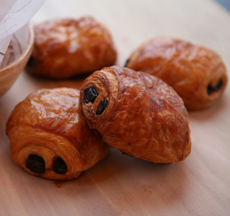
Pain au chocolate from Tisserie.com. |
PAIN AU LEVAIN
French for sourdough bread. These can be found in crusty oblong loaves and in round loaves, called boules (pronounced bools).
PAIN AUX NOIX
Nut bread. See walnut bread.
PAIN DE SEIGLE
French for rye bread. Traditional rustic French rye breads are baked in round loaves and boules.
PAIN DE MIE
The French term for a soft sandwich baked in a straight-sided (Pullman) pan. The result is light years away from commercial American sandwich bread or white bread. Pronounced PAN-duh-MEE-ay, the term refers to the fine, moist crumb of the bread, the result of milk and butter (pain means bread, mie means crumb). The airy, puffy, sugar-laden American sandwich loaves are unfortunate relatives.
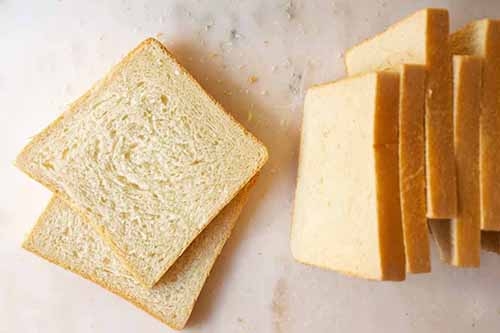
Pan de mie. Here’s the recipe (Gemini Photo).
|
PAN DE SAL or PANDESAL
Literally, salt bread, pan de sal is a Filipino breakfast roll staple. Made with flour, eggs, lard, yeast, sugar, and salt, it tends to be on the sweet side rather than a savory bread, fluffy on the inside and crusty on the outside. Pan de sal is often made with rich fillings like sticky coconut jam or over-easy eggs.
|
|
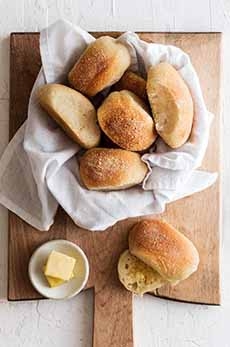
Pan de sal. Here’s a recipe (photo © King Arthur Baking). |
PAN LOAF
These loaves are baked in straight-sided pans for a softer crust and a uniform profile. They are sized for slicing for sandwiches and are sold sliced and unsliced. They can be made from any type of grain, brioche, etc. The typical commercial sandwich loaf is made in a loaf pan. The Pullman loaf is one variety that is a bit different. It’s baked in a pan with a lid so the loaf is perfectly rectangular. |
|
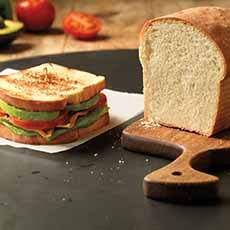
Pan loaf. Here’s a recipe (photo © King Arthur Baking). |
|
PANDORO The star-shaped pandora, “bread of gold” or “golden bread,” sprinkled with confectioners’ sugar, first appeared in late 19th-century Verona. There are two versions of its parenthood, which date back to the Renaissance. The first speaks of the custom of wealthy Venetian bakers to dust gold leaf onto cone-shaped cakes called pan de oro, bread of gold. Today’s powdered sugar is not as luxe, but more affordable and tastier. Others hold that the modern descends from a star-shaped cake called nadalin that the common folk of Verona enjoyed at Christmas.
|
|
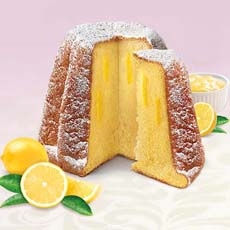
Pandoro (photo © Bauli). |
The star shape enables creative hosts to cut the cake into horizontal layers, then stack them up with zabaglione or whipped cream and decorate them with red and green candied cherries and mint leaves, to represent a Christmas tree.
PANE RUSTICA
See peasant bread.
| PANETTONE
Panettone is a medieval Italian Christmas yeast bread, filled with candied fruits and raisins. Panettone, a Milanese specialty, is tall, dome-shaped, and airy, in contrast to the other famous Christmas bread, panforte, which is short and dense (although there is a less common, flat version of panettone).
The name means “large loaf” in Italian. While the origins of a sweet leavened bread date back to Roman times, and a tall, leavened fruitcake can be seen in a 16th-century painting by Pieter Brueghel the Elder, the first known mention of panettone with Christmas is found in the 18th-century writings of Pietro Verri, who refers to it as “pane di tono.”
The origins of panettone are also linked to the medieval tradition of celebrating Christmas in the family by putting three wheat loaves to be divided among all the diners and to keep one slice, a sign of continuity, until the following year*.
The recipe we know today, however, was only perfected in the late 19th century, when Milanese confectioner Giovanni Felice Luraschi decided to add yeast to obtain a taller and fluffier cake, to be enriched with cubes of candied fruit or sultanas.
The dough is cured for several days (like sourdough), giving the cake its distinctive fluffiness. Raisins, candied orange peel, citron, and lemon zest are added dry; some modern versions add chocolate (which was not available when the recipe originated); others are plain.
The classic Panettone accompaniment is a sweet hot beverage or a sweet wine such as spumante or moscato, but any dessert wine will do. Some Italians add a side of crema di mascarpone, a cream made from mascarpone cheese, eggs, and amaretto (or you can substitute zabaglione). The other popular Italian Christmas bread is panforte, below.
|
|
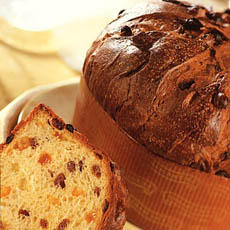
Panettone (photo © Dolce Italia).
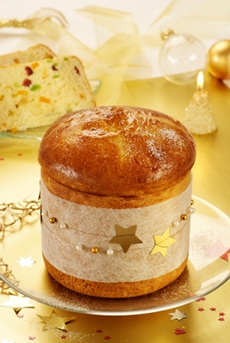 Gaily wrapped for the holidays (photo © Vikif | iStock Photo). Gaily wrapped for the holidays (photo © Vikif | iStock Photo).
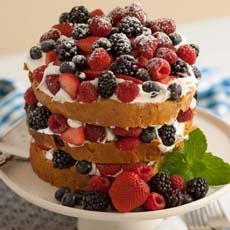
Panettone shortcake (photo © Bauli).
|
Lastly, a legend:
One Christmas Eve, Ludovico il Moro, Duke of Milan (Ludovico Maria Sforza, 1452-1508), was hosting a grand dinner party. A young chef named Toni accidentally burned the dessert. Desperate, he mixed bread dough and butter with raisins and candied fruit and baked another dessert. “Pan del Toni,” which evolved to panettone, was a hit.
______________
*How they stored the bread for a year without freezers, we can only wonder. Even encased in metal, it would decompose.
|
PANFORTE
Panforte, which means “strong bread,” is a traditional Italian dessert, born in 12th-century Siena. A dense mixture of almonds and candied fruit, sweetened with honey and flavored with spices, it was originally called panpepato con miele, peppered (spiced) bread with honey, and was traditionally a Christmas bread baked by nuns.
It became panforte and traveled to other parts of Italy, where variations evolved. In the 1400s in Venice, it was a custom to enjoy the classic panforte prepared in “the ancient Siena way” for important celebrations; in Genoa’s archives, it is mentioned as one of the best-known desserts of Italy.
Over the centuries, many variations of the original recipe developed, as new ingredients became available. In the 1820s, the Parenti bakery introduced a chocolate-laced variety; now the most popular varieties are Panforte Nero and Panforte Margherita.
Panforte Nero (black panforte), as its name implies, is dark: there is some chocolate, and it has an underlying bitter taste from bitter almonds, along with pine nuts, candied citron, lemon rind, flour, sugar, cinnamon, cloves, and black pepper. It is preferred by connoisseurs.
Panforte Margherita is delicate, made of flour, sugar, honey, almonds, nutmeats, candied citron, candied orange peel, and other candied fruit peel, cinnamon, allspice, and coriander, and topped with a dusting of confectioners’ sugar.
The recipe was developed in 1879 by a baker named Enrico Righi and presented to Queen Margherita, who came to see the Palio (the running of the bulls, a major Siena event) with King Umberto every year. Both varieties use a crust of communion wafers.
Today’s recipes are lighter and sweeter than the medieval originals and are served year-round.
|
|
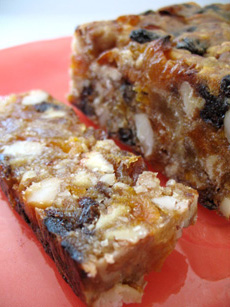
Panforte (photo by Melody Lan | © THE NIBBLE).
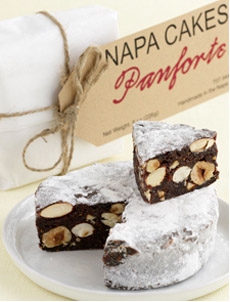
Panforte nero, with chocolate (photo © Napa Cakes [now closed].
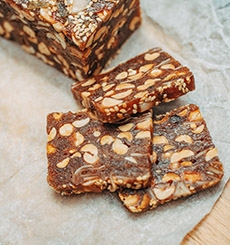
Fig and hazelnut panforte (photo © Fox | Pexels). |
|
PANKO
Panko are coarsely ground Japanese breadcrumbs, more like flakes. They have a large surface area, so they tend to stay crispy longer than regular bread crumbs (and they also absorb less grease). The result is lighter, crisper, and crunchier breading (think tempura coating).
|
|
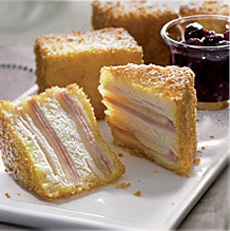
A Monte Cristo sandwich breaded with panko crumbs. Photo courtesy Kikkoman. |
|
PARATHA
A flatbread from the Punjab region of Northern India. Made with whole-wheat flour, it is pan-fried in ghee or cooking oil, and often stuffed with paneer (cheese) and/or vegetables such as boiled potatoes (aloo paratha), radishes, and cauliflower. It is also made in sweet versions, such as chinni (sugar) paratha.
|
|
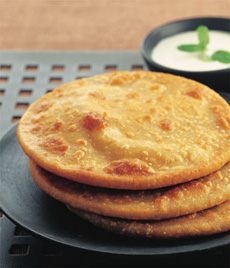
Chinni (sugar) paratha. Photo courtesy ShimaFood.com. Here’s the paratha recipe.
|
PARISIENNE (PAIN PARISIEN)
Pain Parisien (Parisian bread) is generally wider and shorter than a classic baguette, with a softer crust and crumb. This makes it better for everyday slicing and sandwiches. It is sometimes referred to as a flûte.
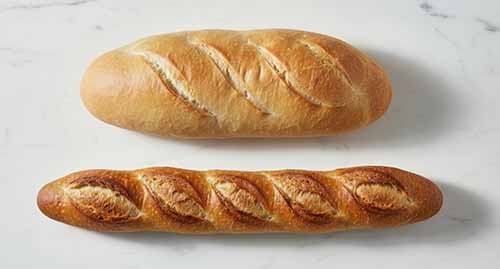
Pain Parisien on top, baguette on the bottom (Abacus Photo).
|
PEASANT BREAD or PANE RUSTICA
Generally, a large, round rustic loaf with a thick crust and a hearty, flavorful crumb. Rural peasants often made this type of simple, satisfying bread with whole grains. The breads were baked in open fireplaces or large brick community ovens since peasants did not have sophisticated kitchens. Most are baked in modern, conventional ovens.
|
|
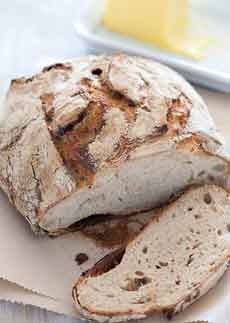
A rustic loaf (photo © The Stone Soup). |
|
PIADINA ALLA ROMAGNOLA
Roman flatbread. Circular and flat like a tortilla, it is used to sandwich foods (grilled sausages and onions, for example), as a snack spread with cheese, and with spreads, among other uses.
|
|
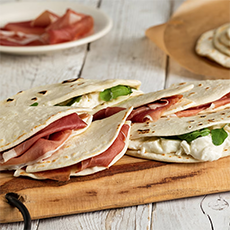
Piadina alla romagnola. Here’s a recipe to make your own (photo © Cucchiaio). |
|
PITA
Pita takes the form of both a thick flatbread and a pocket bread consisting of a double layer of flatbread. Pita is a traditional bread in many Middle Eastern and Mediterranean cuisines from Africa to Greece. Pocket pitas hold other ingredients (falafel, shawarma); traditional pita is used for dips (hummus, tzatziki) and to wrap souvlaki and gyros.
|
|
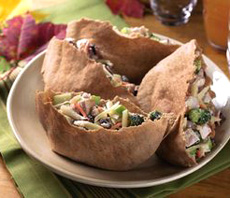
Pita pockets are meant to be filled. Photo courtesy Cabot Creamery. |
| PIZZA
Pizza is a flatbread made in a variety of diameters as a base for cheese, tomatoes, and other toppings. While generally round, it is also made in rectangular and novelty shapes (hearts, e.g.). Most pizza is wheat-based, although whole-wheat and semolina varieties can be found, along with gluten-free options. The difference between a pizza and a flatbread is that pizza dough is a leavened dough, whereas flatbread is unleavened, giving it that flat texture that doesn’t puff up.
|
|
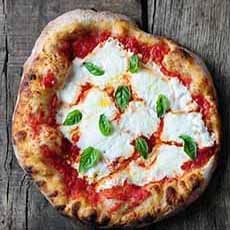
Yes, pizza is a flatbread (photo © DeLallo).
|
POCKET BREAD
A flatbread is formed into a pouch into which other foods can be stuffed. Pita is perhaps the most familiar example (see photo above).
POORI or PURI
One of the unleavened breads of India, poori is made from whole-grain durum wheat flour (atta), water, and salt, and deep fried in ghee or vegetable oil, where it puffs up into pillows (which gradually deflate). Pieces are torn off and used to scoop up lentils, rice, and other vegetables.
|
|
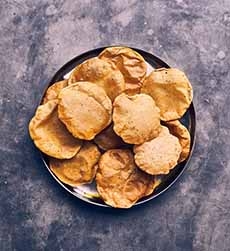
Poori (photo © Ppy2010ha | Dreamstime). |
|
POPOVER
A quickbread, the popover is an Americanization of Yorkshire Pudding. A popover is an egg batter cooked in custard cups or muffin tins to produce a very light, hollow roll—essentially, an eggy crust. The name comes from the fact that the batter swells or “pops” over the top of the cup while baking. Popovers need to be eaten hot, or they become rubbery. Here’s more about popovers and the history of popovers.
|
|
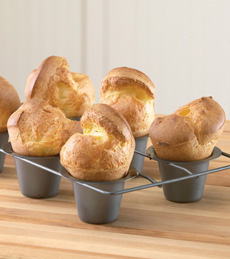
Popovers (photo © at Chefs Catalog [now closed]). |
PORTUGUESE SWEET BREAD
Called massa sovada in Portuguese, this lightly sweet, round loaf made with milk, sugar, and/or honey, is popular as a breakfast bread. Traditionally, a Christmas and Easter holiday bread, baked with hard-boiled eggs for Easter, it is now available year-round. While it's traditionally served plain or with butter, it also makes delicious toast and French toast. The King’s Hawaiian brand is a variation of Portuguese sweet bread. |
|
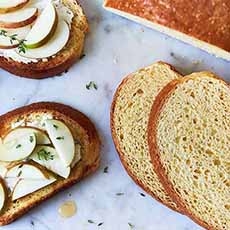
Portuguese sweet bread. Here’s a recipe (photo © King Arthur Baking). |
|
POTATO BREAD
In potato bread, potato replaces a major portion of the wheat flour. It developed in Ireland as a way to use mashed potato leftovers.
PRETZEL (SOFT)
A soft pretzel is actually a type of yeast bread, rolled into a long rope and knotted.
PRETZEL CROISSANT
See Bavarian croissant.
|
|
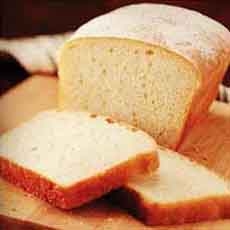
Potato bread. Here’s a recipe (photo © Dietz and Watson). |
PUFF PASTRY
Classic puff pastry (pâte feuilletée or pâte feuilletage) is a wheat dough spread with butter or other solid fat and repeatedly rolled out and folded. It creates a soft, buttery, flaky bread. Croissants are made with a variation of puff pastry dough that contains a small amount of yeast to aid in leavening (as does Danish dough); classic puff pastry uses only steam to rise. Cheese straws, napoleons, turnovers, and numerous crusts and shells are made from puff pastry. Unlike so many origins that are lost to history, we actually know the inventor of puff pastry. Around 1645, a French apprentice pastry chef named Claudius Gele created a special loaf of bread for his sick father, whose diet consisted of water, flour, and butter.
|
|
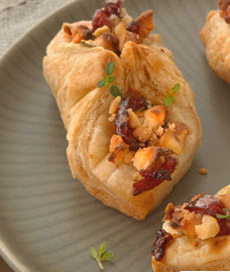
Puff pastry hors d’oeuvres. Photo courtesy Pepperidge Farm. |
Claudius prepared a dough and packed butter into it, kneading and folding the dough ten times before molding it into a loaf. Claudius’ master felt the butter would just run out once the dough went into the oven. Both chefs were amazed at the size it attained. As it turns out, moisture in the dough turns to steam; the air trapped in the many foldings expands when heated, causing the pastry to puff and separate into hundreds of flaky and thin layers, pushing it up and out in every direction. While one of Claudius’ subsequent employers claimed to have invented puff pastry, he kept his secret to himself, always prepared his pastries in a locked room, and was a highly regarded artist.
PULL APART BREAD
A softer style of bread that is scored and brought to the table whole, to be pulled apart. The dough is scored before baking to make it easy to pull apart. Monkey bread (round) and Parker House rolls (rectangular) are examples. Often rolls are joined to be pulled apart after baking, but there are also pull-apart loaves as in the photo. The breads can be sweet, often with sugar and cinnamon or an icing glaze, or they can be savory (cheese pull-apart bread is delicious).
|
|
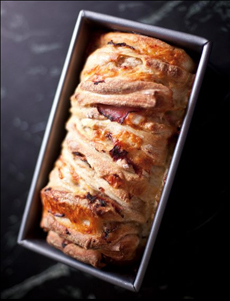
A cheesy pull-apart bread from Artisan Bread In Five Minutes A Day. |
PULLMAN LOAF or PAIN DE MIE
A Pullman loaf, also known as a sandwich loaf, is a white or whole wheat bread baked in a long, narrow, lidded pan; the lid slides on and off the grooves in the pan. The lid creates a flat top and even rectangles for making sandwiches (as opposed to a curved top crust). While the origin of the name is uncertain, some say the shape of the loaf made it easier to store aboard railway dining cars, or that the loaf or the pan resembled the shape of a railroad car. Sweet loaf breads, such as banana bread, are sometimes called sweet Pullmans.
|
|
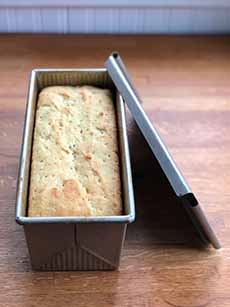
A Pullman loaf (photo © King Arthur Baking). |
PUMPERNICKEL BREAD
Pumpernickel is a dark, dense rye bread made from crushed or ground rye grains. It can be dark brown to almost black. Pumpernickel is baked for a long period at a low temperature in a covered tin; the long baking time is responsible for the dark color. Like most rye breads, it is made with a sourdough starter. There are different types of pumpernickel, most notably the German Westphalian pumpernickel, a dense bread made from 100% rye flour, including crushed or ground whole rye grains, and a sourdough starter, with a profound rye flavor; and American Jewish-style pumpernickel, which contains wheat flour and has a milder flavor and more porous crumb than the Westphalian pumpernickel.
|
|
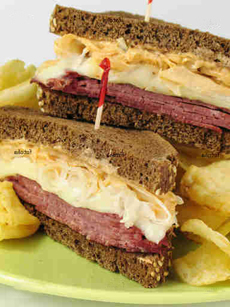
A Reuben sandwich on pumpernickel bread. Photo © Dream Big Photos | Fotolia. All about the Reuben sandwich. |
PUPUSA
A pupusa is a stuffed corn tortilla from El Salvador. It can be filled with any variety of chopped meat, vegetables, and/or cheese. Pupusas are traditionally served with a side of curtido, a cabbage slaw with vinegar, and salsa roja, a puréed tomato sauce with onion, garlic, chile, and oregano. Here’s a recipe.
|
|
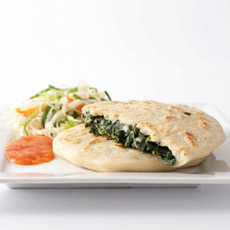
A pupusa filled with spinach and cheese. Photo courtesy TresPupusas.com. |
Continue To Page 8: Terms Beginning With Q To S
Go To The Glossary Index Above

|





























